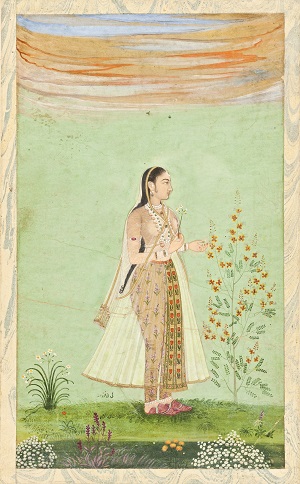The Floral Empire: Flowers in the Arts of Mughal South Asia
By Nicolas Roth
Nicolas is a PhD student in South Asian Studies working on a dissertation about the garden culture of Mughal India. When not reading seventeenth- and eighteenth-century South Asians' accounts of what they were growing, he is usually trying to grow what they were growing. Please visit him at IG: nic_in_the_garden
Flowers have always had their place in South Asian art, but they were perhaps never as prominent as in the seventeenth and eighteenth centuries. The Mughal Empire, originally founded in 1526 when Zahīr al-Dīn Muhammad Bābur (1483-1530), a descendant of Genghis Khan and Timur the Great from Fergana in what is now Uzbekistan, conquered Delhi and Agra, expanded to encompass all but the southernmost reaches of the Indian Subcontinent before slowly declining in favor of numerous local centers of power that carried on and adapted its cultural heritage.
Beginning with the reign of Emperor Jahāngīr (r. 1625-1627), Mughal art and architecture developed new styles quite different from what came before, less beholden to earlier models from both Central Asia and India itself, and imbued with a distinctive form of realism that would be reflected in various ways throughout the region for the next two centuries. Jahāngīr is well known for his passionate interest in plants and animals, and his court painter Mansūr was frequently commissioned to produce detailed and scientifically accurate images of the monarch’s collections of flora and fauna. Unfortunately, very few of Mansūr’s botanical studies survive today. Yet flowering plants increasingly appeared everywhere – as the subject of sophisticated painterly studies in their own right like those executed by Mansūr and in the lush garden settings of many a painted scene, but also as ornamental patterns in the margins of miniatures or calligraphy; adorning walls as murals, pietra dura inlay or mirrorwork, or carved in relief; printed, woven, or embroidered on textiles; carved into jade or rock crystal cups or flasks; forged from metal, pearls, and precious stones on jewelry and weapons – and they were central to socio-cultural practices and ideals.
The Mīrzānāmah, a mid-seventeenth-century treatise on how to be a proper mīrzā or aristocratic gentleman, returns to the matter of flowers repeatedly and ties their proper appreciation and use to a man’s character, sophistication, and masculinity. It advises that a gentleman is naturally inclined to appreciate flower gardens and should therefore lay them out wherever possible on his property; that a house without potted plants and vases filled with seasonal bouquets is a house without joy; that a mīrzā ought to be interested in unusual and multicolored flowers and if he wants to smell one he should pluck it himself so as to avoid potential pollution through the touch of someone else; and that he ought not to wear flowers in his turban “for it is a beloved’s [as opposed to a lover’s, i.e. an effeminate] thing to do and a mīrzā takes being an effeminate lover to be a fault” – except perhaps in private a rose because it is the flower of Muhammad, or a sprig of larkspur since it resembles a feather and will look particularly nice.
Larkspur also appears in a passage from the foreword the Mughal courtier Ānand Rām ‘Mukhlis’ (1699-1750) wrote for the album containing his collection of miniature paintings that beautifully encapsulates the way in which floral imagery and knowledge of flowers and horticulture, ideals of cultural sophistication, literary norms, and the visual arts came to be entwined. If the architecture of his [the creator’s] invention had not paid attention to the organization of the album of spring, who would have have arranged margin notes of larkspur for the text of the corn poppy bed? The contrasting combination of tall, dark blue larkspur and luscious red or pink corn or Shirley poppies was and is a popular one in South Asian horticulture; it appears frequently in artwork from the seventeenth and eighteenth centuries and is often referenced in literature from the period. This is part of the botanical and horticultural realism that is such a notable feature of South Asian artwork from this era. There were, to be sure, plenty of floral patterns that were imaginary creations; ironically, many flower motifs that were based on European prints, including some of those used in the ornamentation of the Taj Mahal, are botanical nonsense, combining parts of what are in fact wildly different species or giving fantastical coloring to flowers the artist had clearly never seen in real life. Yet just as often, artists in various media produced acutely observed, clearly recognizable depictions of plants. Interestingly, in doing so they appear to have had clear favorites. Of the enormous wild and cultivated flora of the Indian Subcontinent and the myriad species from the Americas and East Asia that were introduced during Mughal times, some are depicted constantly – among them poppies and larkspur, cockscombs, forms of Narcissus tazetta, and marigolds – but many more appear rarely or never.
Sometimes regional preferences are discernable as well. Plumerias, for instance, almost never appear in pre-colonial South Asian art - except at the connected Rajput courts of Kota and Bundi in Rajasthan, where from the middle of the seventeenth century, Plumeria rubra var. acutifolia, a distinctive form with cream-and-yellow blossoms that never fully unfurl, appears in the background of virtually every painting, stylized yet identifiable. Much remains to be explored and properly understood regarding the role of flowers and plants in the arts and culture of Mughal South Asia; where they may often fill margins, they are far from mere marginalia.















